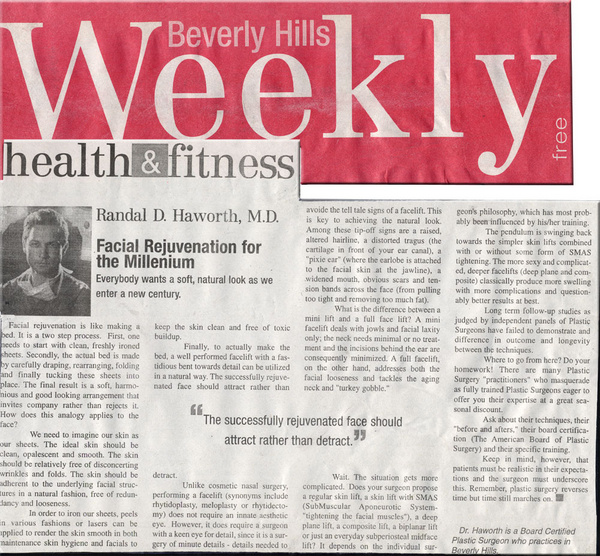In order to iron our sheets, peels in various fashions or lasers can be applied to render the skin smooth in both maintenance skin hygiene and facials to keep the skin clean and free of toxic buildup. Finally, to actually make the bed, a well performed facelift with fastidious bent towards detail can be utilized in a natural way. The successfully rejuvenated face should attract rather than detract. Unlike cosmetic nasal surgery, performing a facelift (synonyms include rhytidoplasty, meloplasty or rhytidectomy) does not require an innate aesthetic eye. However, it does require a surgeon with a keen eye for details, since it is a surgery of minute details – needed to avoid the tell tale signs of a facelift. This is key to achieving the natural look. Among these tip-off signs are raised, altered hairline, a distorted tragus (the cartilage in front of your ear canal), a “pixie ear” (where the earlobe is attached to the facial skin at the jawline), a widened mouth, obvious scars and tension bands across the face (from pulling too tight and removing too much fat).
What is the difference between a mini lift and a full face lift? A mini facelift deals with jowls and facial laxity only; the neck needs minimal or no treatment and the incisions behind the ear are consequently minimized. A full facelift, on the other hand, addresses both the facial looseness and tackles the aging neck and “turkey gobble.” Wait. The situation gets more complicated. Does your surgeon propose a regular skin lift, a skin lift with SMAS (SubMuscular Aponeurotic System “tightening the facial muscles”), a deep plane lift, a composite lift, a biplanar lift or just an everyday subperiosteal midface lift? It depends on the individual surgeon’s philosophy, which has most probably been influenced by his/her training.
The pendulum is swinging back towards the simpler skin lifts combined with or without some form of SMAS tightening. The more sexy and complicated, deeper facelifts (deep plane and composite) classically produce more swelling with more complications and questionably better results at best.
Long term follow-up studies as judged by independent panels of Plastic Surgeons have failed to demonstrate and difference in outcome and longevity between the techniques.
Where to go from here? Do your homework! There are many Plastic Surgery “practitioners” who masquerade as fully trained Plastic Surgeons eager to offer you their expertise at a great seasonal discount. Ask about their techniques, their “before and afters,” their board certification (The American Board of Plastic Surgery) and the specific training.
Keep in mind, however, that patients must be realistic in their expectation and the surgeon must underscore this. Remember, plastic surgery reverses time but time still marches on.
Dr. Haworth is a Board Certified Plastic Surgeon who practices in Beverly Hills.

